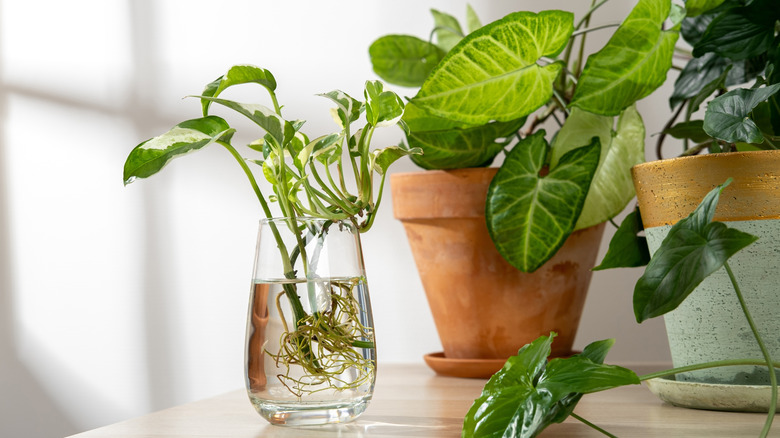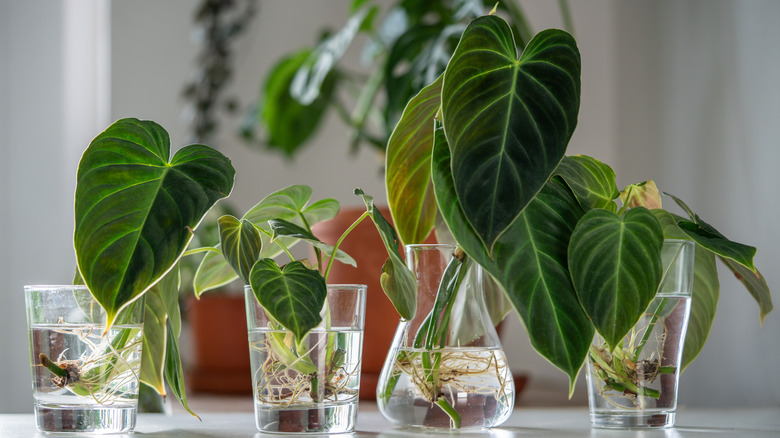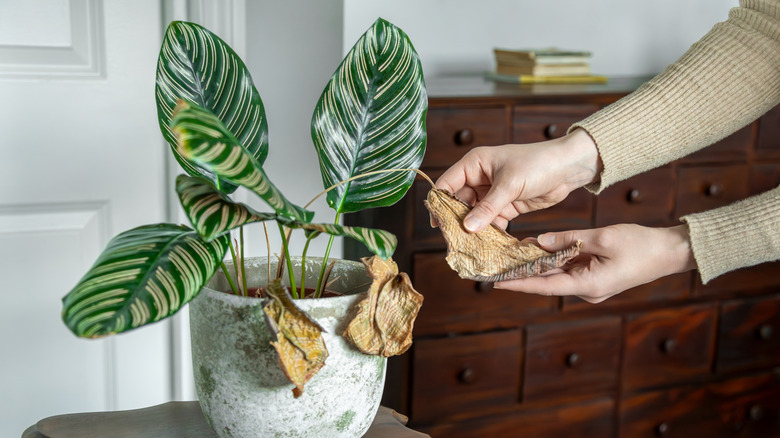You Only Need A Jar Of Water To Grow This Gorgeous Houseplant
Keeping houseplants can offer benefits to your mental health. Plenty of different plants also brighten up a room as décor, regardless of the space having good access to light or other growing features. If anything, one of the biggest mitigating factors to filling your home with beautiful indoor plants is that creeping sense that you do not have a green thumb. Growing something like a zebra plant (Aphelandra squarrosa) from scratch is a good way to dissuade these concerns. All you need to start is a cutting and a jar of water.
Zebra plants are short-lived, slow-growing perennials that are native to Brazil. They grow best in moist, tropical conditions that fit USDA hardiness zones 11 and 12. Because of that native growing environment, the zebra plant is an ideal choice for water propagation during the spring and summer months; stem cuttings that you obtain from pruning are considered a good way to keep the plant on constant display at home. Propagating plants from cuttings will get you to the flowering stage faster than starting with seeds and doing so lets you carry forward characteristics like flower color from the parent. As far as how to obtain these first cuttings, you can always seek out a plant shop, ask a neighbor or friend with a healthy garden, or offer to give someone's dying plant a new lease on life.
How to propagate zebra plants in water, and plant healthy cuttings
Water propagation can be done via leaves, stem sections, or the tips of branches. Stem sections are an easy place to begin while you are figuring out everything you need to know to start planting zebra plants. Cut a stem that is around 3 to 5 inches with at least one node — these are the bumps in which two sections of the stem connect, where the petiole and leaf will grow. The water you are using to propagate should fully submerge a node, meaning you will want to cut lower leaves on the stem to ensure it fits. The process of growing roots can take several weeks, so replace the water whenever it starts to look yellow, or it gets thick (ideally one to two times a week). Allow roots to develop in a light, pathogen-free environment so the zebra plant cutting can be transplanted once roots are about an inch long.
Zebra plants require a good amount of light but should not be exposed directly to the sun. Once you have propagated your cuttings, plant them in loam-quality soil with high organic matter, soil with an acidic pH level and good drainage. If roots grow coarse while propagating in water, they might require extra care in the soil. That soil should be kept consistently moist between March and December but should be dried out between watering during winter months. To improve the quality of your root cutting, mix a soluble fertilizer into the water-based propagation medium every three months.
Keep an eye on your indoor zebra plant's health once it's grown
Though your journey with zebra plants may start with little more than cuttings and a jar of water, you will have more to consider once the houseplant is grown. A zebra plant can grow upward of 6 feet, so plan ahead by leaving it plenty of room. While you want to keep your zebra plant's growing medium nice and moist, overwatering can cause its leaves to brown and fall off. Frequent pruning to control the number of stems will prevent zebra plants from losing their leaves, and these cuttings can be used to add onto your collection. Zebra plants may also be subject to a number of fungal infections, including botrytis blight, Myrothecium leaf spots, and pythium root rot.
Insect pests can be a problem for zebra plants, so watch out for infestations of aphids, white flies, spider mites, or mealybugs. Fungus gnats can also be a common nuisance around zebra plants and are known to attract parasitic wasp species. Soap or oil-based sprays are good to keep around as pest control, which you can apply as needed. These are just a few of the potential problems to keep in mind when growing zebra plants indoors, but do not let that deter you from giving this propagation a shot. Zebra plants produce beautiful golden bract flowers over a long period that make them worth the effort.


